Translate this page into:
Epidemiology of ocular trauma

*Corresponding author: Shimpa Kundan, Department of Ophthalmology, University College of Medical Sciences, New Delhi, India. shimpak@gmail.com
-
Received: ,
Accepted: ,
How to cite this article: Kundan S, Sharma A, Sahu PK, Das GK, Jatab AS, Aamir PA. Epidemiology of ocular trauma. Lat Am J Ophthalmol. 2024;7:17. doi: 10.25259/LAJO_16_2024
Abstract
Objectives:
The aim of this study was to determine the epidemiology of ocular trauma seen in a tertiary care hospital.
Material and Methods:
The ophthalmology and emergency department in a tertiary care hospital were the sites of this prospective cross-sectional research that ran from July to December of 2023. Trauma was categorized using the Birmingham Eye Trauma Terminology System after a thorough history of trauma and ocular examination. Age, sex, injury mechanism, injury type, and treatment were the variables used for statistical analysis.
Results:
Among the 477 patients, the age group of 21–30 years old constituted 30% of the patient population. Three hundred and thirty-six patients were male (70%) and the rest were female. Right eye (49%) and left eye (50%) were equally involved and the remaining 1% was with both eyes. Most commonly closed globe injuries (88%) were seen among which lid laceration (14%), ecchymosis (12%), and subconjunctival hemorrhage (7%) were common. Mechanism of injury commonly causing ocular trauma was road traffic accidents (33%). Most of the patients were non-surgical involving lid suturing (21%) and medical management. About 17% of cases needed surgical repair.
Conclusion:
This study focuses on epidemiology of ocular trauma. Accidents using motor vehicles were the leading cause of eye injuries. Increasing general awareness and preventing delay in treatment can overcome visual morbidity and thus reduce incidence of permanent visual disability.
Keywords
Ocular trauma
Birmingham Eye Trauma Terminology System
Open globe injury
Closed globe injury
Road traffic accidents
INTRODUCTION
One of the most common causes of blindness is damage to the eye by trauma.[1] Worldwide, traumatic damage causes uniocular blindness in around 19 million individuals.[2] Ocular trauma includes trauma to globe, orbit, optic nerve, and adnexa and among these 90% ocular injuries are preventable.[3]
The eyeball is well protected structure by eyelids, eyelashes, and orbital margins which prevents direct damage to the eye. The physiological protective mechanisms include blink reflex, head- turning reflex, and lacrimation for any foreign body entering the eye.
Due to factors such as low socioeconomic status, insufficient safety measures, a lack of proper facilities, and poor education, the effects of eye injuries are more severe in developing nations.
Trauma can cause injuries ranging from superficial to vision-threatening complications.
There are various classifications of ocular injuries, but most globally accepted classification is Birmingham Eye Trauma Terminology System (BETTS).[2] Injuries are often classified by BETTS as either open globe (rupture, laceration, intraocular foreign body, perforating, and mixed) or closed globe (contusion, lamellar laceration, superficial foreign body, and along with mixed).
According to statistics, the incidence of ocular trauma in India varies from 1% to 5%.[4] Due to low socioeconomic status and literacy of the majority of the population in India, the awareness among patients regarding management of post ocular trauma is less compared to developed countries. Most of these injuries can be prevented by raising awareness and early intervention.
Classifying ocular trauma helps establish a standard for damage severity documentation, which, in turn, facilitates the use of globally acceptable vocabulary and descriptions.
The main goal of this project is to collect comprehensive epidemiological data that may be used to develop preventative interventions and ultimately reduce avoidable cases of eyesight loss.
MATERIAL AND METHODS
The study was carried out from July to December 2023 at the Ophthalmology and Emergency department of tertiary care hospital in North India. It was a prospective and cross-sectional study. Participants comprised patients of any age who consented to participate in the study and presented with ocular injuries.
We obtained ethical committee clearance for the project. In a well-structured pro forma, we recorded every patient’s medical history, including relevant demographic information (such as age and gender) as well as data on the exact injury type and degree. Visual acuity followed by assessment of anterior and posterior segment of the eye was done.
We used IBM SPSS Statistics for Windows to analyze the data that we obtained. A pattern of the distribution of the variables was observed by generating frequencies, means, and standard deviations. Significant results were defined as P <0.005.
Inclusion criteria
Patients with ocular trauma reporting to the ophthalmology outpatient department and emergency were included in the study.
Exclusion criteria
Nil.
Sample size
This was all 477 individuals who came to the hospital between July to December of 2023 complaining about eye injuries.
RESULTS
This study included patients ranging from 1 to 90 years of age out of which most common age group was 21-30 years of age. Younger age group i.e. third decade of age group were most common and >70 years of age were least involved in ocular trauma.
Out of the total 477 patients ,336 patients were male which constituted 70% of our total patients whereas females comprised of 30% (141).
Among 477 patients, right eye was involved in 49% (235), left eye in 50% (237) and both eyes were involved in remaining 1% (5).
Of note, 12% (57) cases were open globe injuries and remaining 88% (420) were closed globe injuries according to BETTS classification.
According to mechanism of injury 33% (159) of total patients had ocular trauma due to road traffic accidents, followed by physical assault which was 22% (105). Figure 1 shows a pie chart with percentage of common cause for ocular trauma [Table 1].
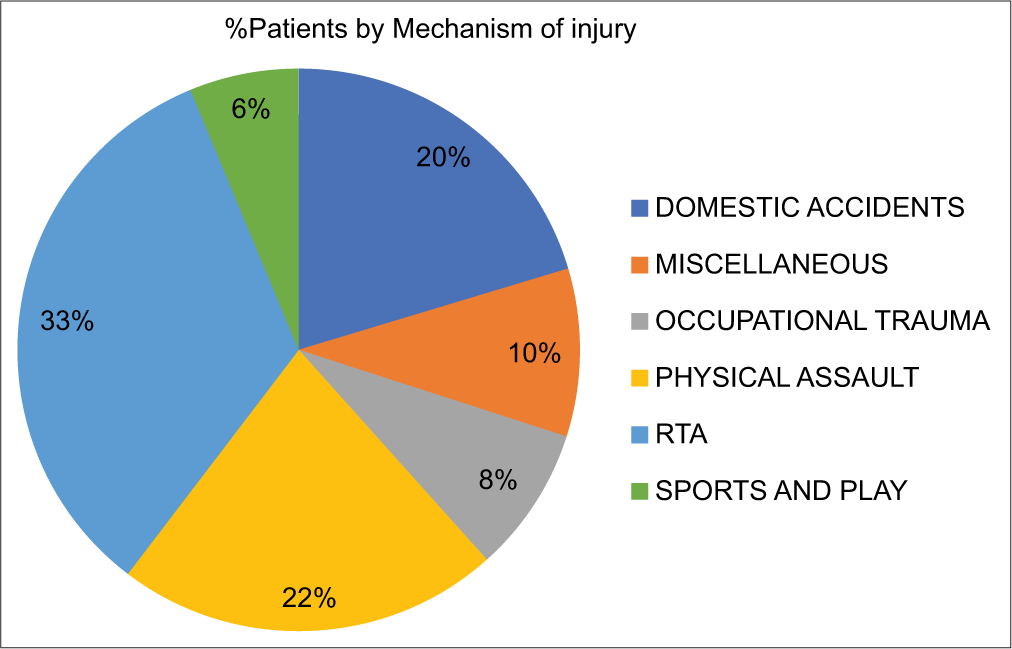
- A pie chart with percentage of common cause for ocular trauma 33% road traffic accident,22% physical assault,20% domestic accidents,10%miscellaneous,8% occupational trauma,6% sports and play. RTA: Road traffic accident
| M.O.I | Count | Percentages |
|---|---|---|
| Domestic accidents | 97 | 20 |
| Miscellaneous | 46 | 10 |
| Occupational trauma | 40 | 8 |
| Physical assault | 105 | 22 |
| Road traffic accident | 159 | 33 |
| Sports and play | 30 | 6 |
In our study, according to injury subtypes majority of patients were lid laceration 14% (68) followed by ecchymosis 12% (57) and further by sub conjunctival haemorrhage 7% (34)[Table 2 and Figure 2].
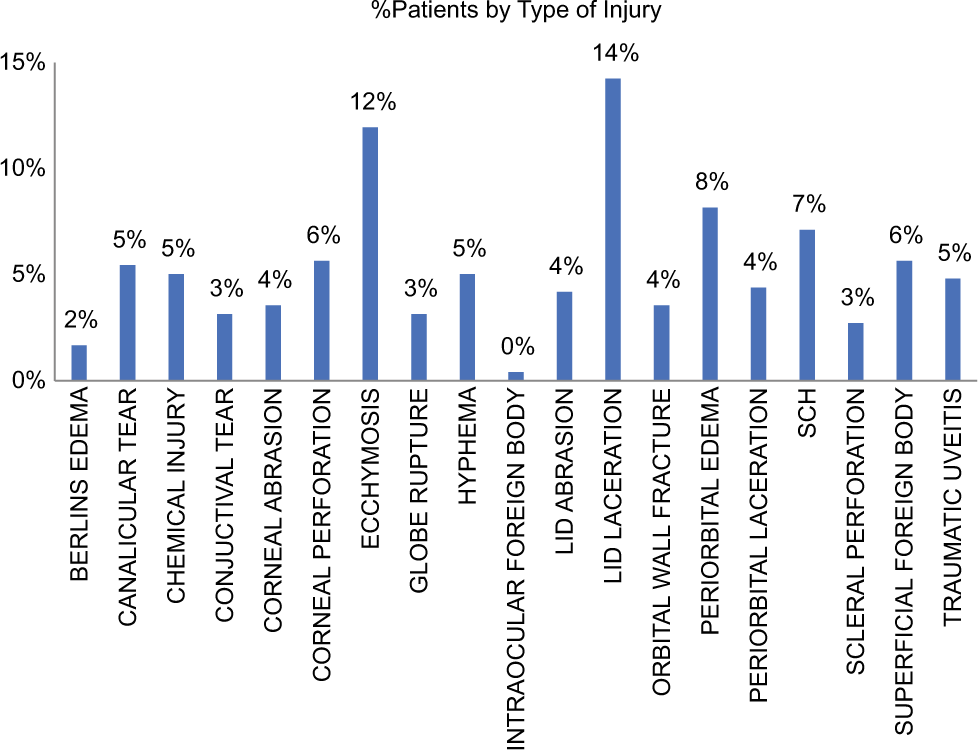
- Bar graph for comparison of common ocular trauma (Lid laceration,ecchymosis, periorbital edema are the most common)
| Type | Count | % |
|---|---|---|
| Lid laceration | 68 | 14% |
| Ecchymosis | 57 | 12% |
| Periorbital edema | 39 | 8% |
| Sch | 34 | 7% |
| Superficial foreign body | 27 | 6% |
| Corneal perforation | 27 | 6% |
| Canalicular tear | 26 | 5% |
| Chemical injury | 24 | 5% |
| Traumatic uveitis | 23 | 5% |
| Hyphema | 24 | 5% |
| Corneal abrasion | 17 | 4% |
| Lid abrasion | 20 | 4% |
| Orbital wall fracture | 17 | 4% |
| Periorbital laceration | 21 | 4% |
| Conjuctival tear | 15 | 3% |
| Globe rupture | 15 | 3% |
| Scleral perforation | 13 | 3% |
| Intraocular foreign body | 2 | 0% |
Since majority of patients were lid laceration, lid suturing (21%) was the main management followed by medical management for ecchymosis [Table 3 and Figure 3].
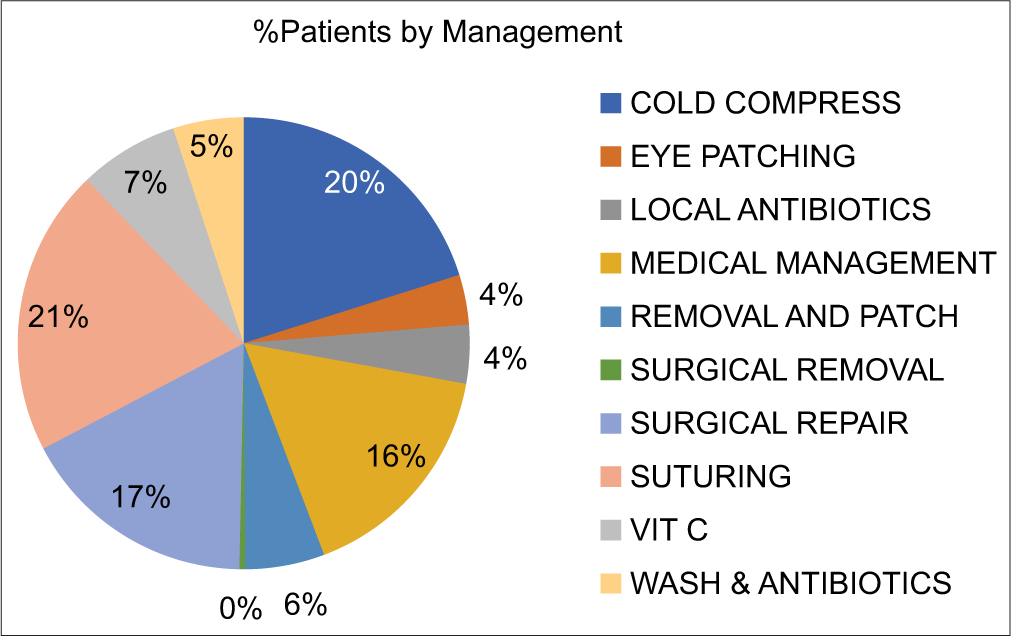
- Showing pie chart for percentage of patients of ocular trauma management.
| Management | Count | % |
|---|---|---|
| Cold compress | 96 | 20% |
| Eye patching | 17 | 4% |
| Local antibiotics | 20 | 4% |
| Medical management | 78 | 16% |
| Removal and patch | 27 | 6% |
| Surgical removal | 2 | 0% |
| Surgical repair | 81 | 17% |
| Suturing | 98 | 21% |
| Vit c | 34 | 7% |
| Wash & Antibiotics | 24 | 5% |
DISCUSSION
Ocular trauma has been a major cause of monocular vision impairment[2] and blindness in recent times. In this hospital- based study, 477 patients were enrolled during 6-month duration of this study.
In our study, 3rd decade of life were commonly involved in ocular trauma (30%). The majority of patients were between the ages of 31 and 40, according to research by Wagh and Tidake[5] Maurya et al.,[6] in their study found pediatric age to be most common. Poy Raiturcar et al.[7] reported highest prevalence in age group of 21–40 years of age which was similar to our study. Due to the incidence of ocular damage caused by physical assault and traffic accidents, our research found a greater prevalence among those aged 21–30.
While 30% of injuries occurred in females, 70% occurred in males in our research. Wagh and Tidake[5] showed males constituted 88.33% and females 11.67%. Agrawal et al.[8] found similar data comprising of 84.8% males and 15.2% females. Other research on ocular injuries have also shown a male preponderance, with a ratio of 2.3:1.[9-11]
In our study, 49% were involving right eye, 50% were involving left eye ocular injury, and 1% were both eyes. According to Wagh and Tidake,[5] 45% of cases affected the right eye and 55% involved the left eye. Almost all injuries were unilateral.
Mechanism of injury in our study showed that 33% of the cases were caused by road traffic accidents followed by physical assault (22%) and 20% domestic accidents [Table 1 and Figure 1]. Mode of injury in study by Wagh and Tidake[5] was 56.67% cases in road traffic accident. Road traffic accidents accounted for 23.6% in the research by Maurya et al.[6] and 40% in the study by Kumar and Vishwas both of which found similar findings.[12]
The majority of research found that ocular injuries in Northern India were caused by traffic accidents, which suggests that road safety measures are not a priority.
About 88% of total injuries were closed globe while 12% were open globe injuries as per BETTS[1] classification in our study. A study by Wagh and Tidake[5] showed similar results with 80% being closed globe injuries and 20% open globe [Figure 2]. Poy Raiturcar et al.[7] showed 90% of patients closed globe injuries. Shukla et al.[13] observed closed globe injuries 66.7% whereas the rest 26.7% were open globe. Open globe injuries were found to be less in comparison to closed globe injuries due to several anatomical and physiological protective mechanisms of eye.
About 14% of total injuries were lid laceration followed by ecchymosis (12%) and periorbital edema (8%). Two cases out of 477 showed intraocular foreign body, eight cases showed Berlin’s edema. About 6% of total cases were corneal perforation, 5% were canalicular tear [Figure 4], 3% cases were globe rupture, and 3% cases were scleral perforation. Table 2 shows a list of common ocular trauma.
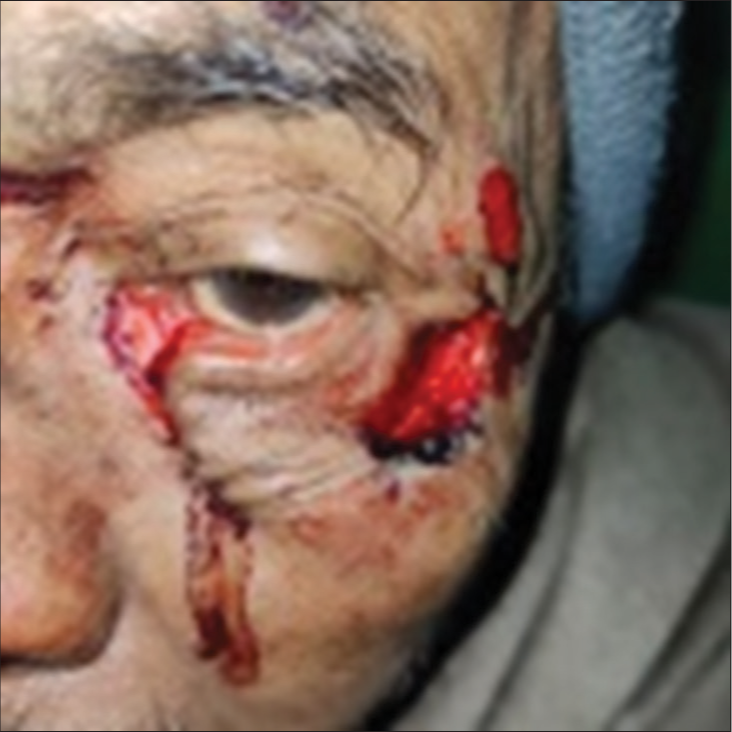
- Left eye lower lid canalicular tear along with periorbital skin abrasion.
Wagh and Tidake[5] showed lid laceration [Figure 5] (71.67%) followed by subconjunctival hemorrhage (16.67%) as common types of ocular trauma. Study by Pai et al[14] showed subconjunctival hemorrhage (37.5%) followed by lid laceration (31.2%).
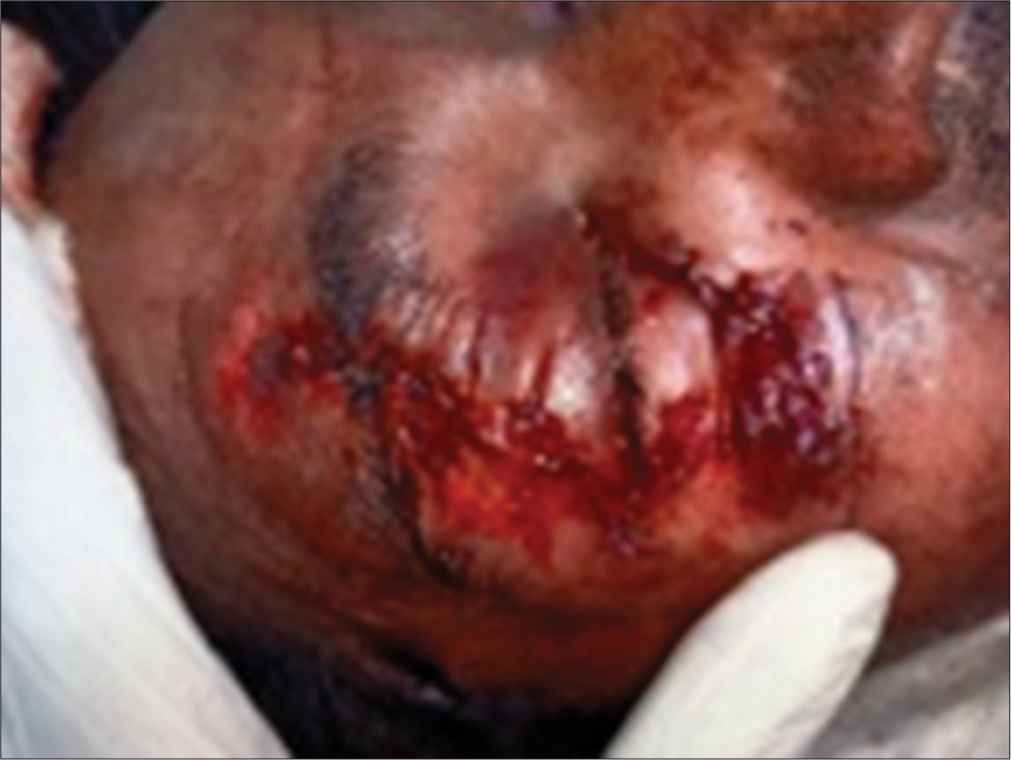
- Lid laceration post suturing.
Patients with ocular injuries were mostly non-surgical. The most prevalent kind of therapy for ecchymosis was cold compresses (20%), followed by suturing [Figure 6] (21%), due to the high prevalence of lid laceration as an ocular trauma type. About 17% cases needed surgical intervention for corneal perforation [Figure 7 and 8], canalicular tear, globe rupture, and scleral perforation.
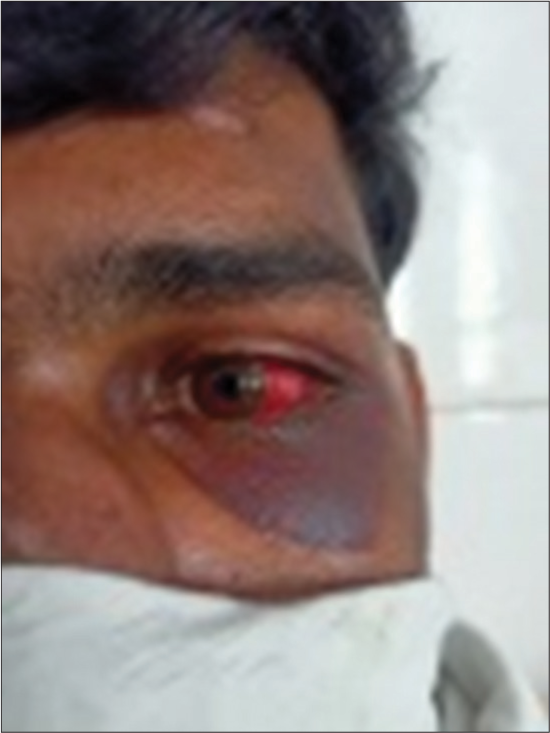
- Left eye subconjunctival hemorrhage with periorbital ecchymosis.
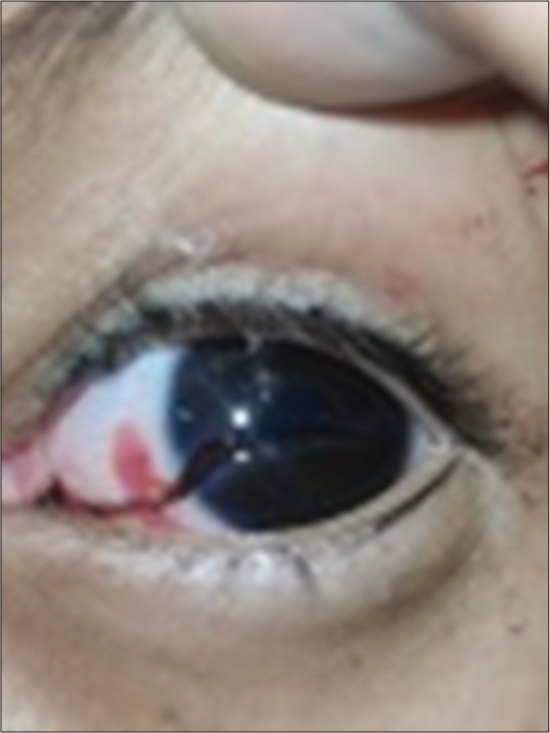
- Sclerocorneal perforation- open globe injury.
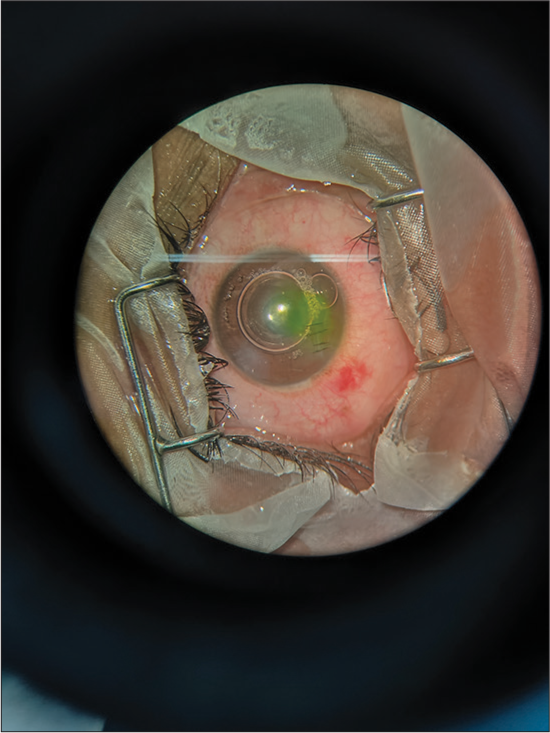
- Corneal perforation repair done by suturing.
About 16% of total cases were medical management including steroids for traumatic uveitis and hyphema, NSAIDs for Berlin’s edema. Study by Maurya et al.[6] showed that 50% of patients were treated medically while 40% required surgical intervention [Figure 6].
CONCLUSION
The study examines the prevalence of eye injuries in a tertiary care hospital in North India. To prevent long-term vision loss, prompt medical attention is necessary in cases of ocular trauma. Safety equipment such as helmets and goggles, as well as prompt medical attention in the case of an accident, may greatly reduce the likelihood of ocular morbidity, which is how the public has to be made more aware of this danger.
Acknowledgment
We like to acknowledge all my colleagues who helped me in collecting data, my consultants who helped me in guiding about the study. We also like to thank all the patients who participated in the study.
Ethical approval
Ethical approval was obtained from the Faculty and Head of Department of University College of Medical Sciences and Guru Teg Bahadur Hospital, UCMS GTB OPHTHAL, number 8235 dated 15th March 2023.
Declaration of patient consent
The authors certify that they have obtained all appropriate patient consent.
Conflicts of interest
There are no conflicts of interest.
Use of artificial intelligence (AI)-assisted technology for manuscript preparation
The authors confirm that there was no use of artificial intelligence (AI)-assisted technology for assisting in the writing or editing of the manuscript and no images were manipulated using AI.
Financial support and sponsorship
Nil.
References
- The global impact of eye injuries. Ophthalmic Epidemiol. 1998;5:143-69.
- [CrossRef] [PubMed] [Google Scholar]
- The Birmingham eye trauma terminology system (BETT) J Fr Ophtalmol. 2004;27:206-10.
- [CrossRef] [PubMed] [Google Scholar]
- The role of eye protection in work-related eye injuries. Aust N Z J Ophthalmol. 1995;23:101-6.
- [CrossRef] [PubMed] [Google Scholar]
- Clinical profile of ocular blunt trauma in a rural hospital. J Clin Ophthalmol Res. 2018;3:3-7.
- [CrossRef] [Google Scholar]
- Clinical study and profile of ocular trauma: Findings from a rural hospital in Central India. Cureus. 2022;14:e26915.
- [CrossRef] [Google Scholar]
- The epidemiology of ocular trauma in Northern India: A teaching hospital study. Oman J Ophthalmol. 2019;12:78-83.
- [CrossRef] [PubMed] [Google Scholar]
- Clinical profile and visual outcome of ocular injuries presenting at a tertiary care hospital in Goa. J Clin Ophthalmol Res. 2019;7:41-4.
- [CrossRef] [Google Scholar]
- Controversies in ocular trauma classification and management: Review. Int Ophthalmol. 2013;33:435-45.
- [CrossRef] [PubMed] [Google Scholar]
- Pediatric eye injuries in upper Egypt. Clin Ophthalmol. 2011;5:1417-23.
- [CrossRef] [PubMed] [Google Scholar]
- Study of clinical profile of ocular trauma at a tertiary eye care centre. Int J Contemp Med Res. 2017;4:4-7.
- [Google Scholar]
- Clinical profile and visual outcome of ocular injuries presenting to tertiary care hospital located on a state highway. Int J Sci Study. 2018;6:76-81.
- [Google Scholar]
- Systematic analysis of ocular trauma by a new proposed ocular trauma classification. Indian J Ophthalmol. 2017;65:719-22.
- [CrossRef] [PubMed] [Google Scholar]
- A clinical study of blunt ocular trauma in a tertiary care centre. Online J Health Allied Sci. 2013;12:10.
- [Google Scholar]






